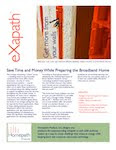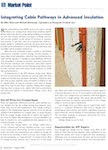While writing this post I stumbled across a New York Times article written by Op-ed Columnist Thomas L. Friedman entitled “More (Steve) Jobs, Jobs, Jobs”. The piece resonated, inspiring me to take a short detour and disclose a bit more about what we’re up to at Homepath Products.
Friedman discussed federal policy-making concerning job creation through innovation. Paraphrasing, he suggests that the current administration should bolster job creation by stimulating our youth through creativity, innovation and entrepreneurship. “What the country needs most now is not more government stimulus, but more stimulation. We need to get millions of American kids, not just the geniuses, excited about innovation and entrepreneurship again. We need to make 2010 what Obama should have made 2009: the year of innovation, the year of making our pie bigger, the year of ‘Start-Up America.’”
Friedman continues “to reignite his youth movement, he [President Obama] should make sure every American kid knows about two programs that he has already endorsed: The first is National Lab Day. Introduced last November by a coalition of educators and science and engineering associations, Lab Day aims to inspire a wave of future innovators, by pairing veteran scientists and engineers with students in grades K-12 to inspire thousands of hands-on science projects around the country...The president should also vow to bring the Network for Teaching Entrepreneurship, or NFTE, to every low-income neighborhood in America. NFTE works with middle- and high-school teachers to help them teach entrepreneurship. The centerpiece of its program is a national contest for startups with 24,000 kids participating. Each student has to invent a product or service, write up a business plan and then do it.”
In general I agree with Friedman. More innovation begets opportunity for success; more success stimulates innovation, in turn, growing the pie and fueling economic expansion. He presents some well conceived ideas echoing an industrial era economist named Joseph Schumpeter who espoused “creative destruction” and focused on the importance of entrepreneurs to strong economies. Friedman adds a noteworthy twist...that is to nourish the innovation and entrepreneurship process through exposure during youth. I find this compelling and believe it may help sidestep the tendency toward risk aversion that sets in with age. This notion parallels what we’re doing in our own small way here at Homepath Products.
For many reasons I traded in the security of corporate America to pursue this new venture called Homepath Products. One (of many) important goals was to spend more time with family. For years I noticed opportunities slipping away while I focused on career, a universal dilemma faced by all parents and those with aging forebears...a challenge with few good answers...part of life.
At Homepath Products we innovate, we experiment, we teach, we are a startup and our kids play a vital role in what we do and, perhaps more importantly, why we do it.
Reflecting on Friedman’s assertion that youth should be energized to nurture creativity and become entrepreneurial consider the following. Our kids also need opportunity to grasp the interconnected nature of things and events, to learn risk taking, and to become aware that they have a voice in matters seemingly beyond their sphere of influence...beneficial lessons for adulthood.
Many regular readers of this blog know that Homepath Products recently introduced the eXapath™ in-wall cable pathway system. With this innovation we aim to improve how homes are designed and built, complementing energy conservation while preparing the structure itself to change as consumer electronics evolve. Not an easy task when wires within walls compete for the same space as insulation.
To see where kids come into the picture you must first understand the product.
Energy Conservation and Upgradeability
One of the many features of eXapath is that, once installed and hidden by drywall, it can be located using a common density-based stud finder. This benefits the home or building owner by enabling the addition of outlets from floor to ceiling. After generations of occupancy the structure remains prepared to adapt when new consumer electronics come to market...without disrupting the insulation envelope.
In shallow inside 2x4” framing, outlets can be added from either side of the wall, in effect serving two rooms. Great for speaker wiring, HDTV, Mirror/TV’s, computer wiring, automation, that sort of stuff.
With deeper outside walls important questions come to light. Today, most exterior walls are built using 2x6” construction. The wall cavities are then completely filled with insulation, except where studs, wires, waste pipes, and electrical boxes reside.
Picturing the installation in an exterior wall, eXapath sits toward the inside of the cavity, in direct contact with drywall. Viewing the system from above note that eXapath has an “H” shape to accommodate our unique snap-in outlets.
With a footprint of 3 3/8” square, 2 to 3 inches of space is provided for insulation. Once installed, eXapath becomes a permanent hollow pathway for low voltage cables enabling moves, adds or upgrades at any time.
Whoa! Did You Say Hollow?
This is a good example of the great questions customers ask...and how they are asked:
”If that thing is in my wall displacing some insulation, what affect does it have on energy conservation?”
The short answer is that eXapath does not present a problem with energy conservation...but it’s a complex question that deserves thorough investigation and a more complete response. Getting to that answer is, well, a science project in heat transfer. A look into the second law of thermodynamics. So, we asked ourselves, in addition to a complete answer, what other benefit can come from this investigation?
Aligning with personal goals the question presents an opportunity for us to bring science out of the class room and into the real world. We’re asking our kids to participate in the exercise in order to help bring practice to much of what they learn in school. We’re involving them in problem definition, design of experiment, measurement, data collection, and analysis. With exposure to an academic project with real world implications, we hope the kids will appreciate that their studies do ultimately prepare them for bigger things. In this case we tie the learning to commonly discussed ideas like energy conservation and sustainability. The students vary in age and academic level but all study the basics including mathematics, global studies, earth science, language arts, etc. They’re actively learning of our interconnected world and often work with abstract problems in homework assignments. Their school teachers bring practice to lessons while reinforcing major points and we hope this magnifies their effort while adding more fun and meaning to the process.
Get ready kids!
Please checkout Part 2 of this series: Kids Don’t Suffer Self-Imposed Limits - We Can Learn From Them
For interim results, skip directly to Part 3: Staggering, Remarkable, Stupendous!









.jpg)


Great article Mike, ties in the societal needs with your product's development. Well done. Garabedian
ReplyDeleteThanks for commenting Mike, I greatly appreciate it. This post was written for a few reasons...one of which is to describe what we do...but also to explain our vision..hoping to raise the bar.
ReplyDeleteThanks,
Mike
As an early adopter of Homepath Products technology, I can confirm everything that you have said. We have lived in our old home for 30 years with absolutely no practical way to add or change low-voltage cables as consumer electronics, computer and networking technologies advances. Therefore, the importance of taking a long-term view of cabling before beginning new construction or extensive remodeling is immediately obvious.
ReplyDeleteThanks for posting this comment. Your note captures the essence of why we designed and brought the eXapath in-wall cable pathway system to market and hints at the disadvantage of having no practical means of changing cables...especially given the rate at which consumer electronics technology changes.
ReplyDeleteInformed homeowners are quick to grasp the idea and benefit by planning for change while they design many of today's advanced systems into their new homes. Energy conservation is critically important and the notion of disturbing the insulation envelope to add, move or upgrade cables works against the principle of energy conserving design. eXapath adds tremendous value by addressing the life-cycle mismatch between the life expectancy of the home and ever-changing technology without impact to energy conservation.
Enjoy your new home for many years and enjoy the ease at which you'll be able to keep pace with technological change.
Thanks again,
Mike